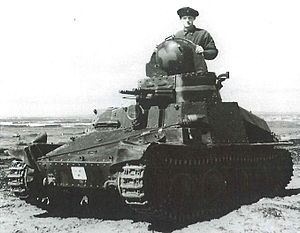Českomoravská Kolben-Daněk was determined not to repeat the problems of its earlier Tančík vz. 33 tankette and gave the gunner a turret for better observation and all-around fields of fire for its new AH-IV tankette. It was assembled from a framework of steel "angle iron" beams, to which armor plates between 12 and 6 mm (0.47 and 0.24 in) thick were riveted. The driver sat on the right side using an observation port protected by bulletproof glass and an armored shutter. To his right was a small vision slit.
Also to his right, in all models except the Swedish Strv m/37, was a light Zbrojovka Brno ZB vz. 26 or vz. 30 machine gun that was usually locked in place and fired using a Bowden cable. The gunner sat on the left and manned a small turret fitted with a ZB vz. 35 or ZB vz. 37 heavy machine gun in a ball mount.
Most of the machine gun's barrel protruded from the mount and was protected by an armored trough. He had a large vision port to the right of the machine gun mount in the turret and a small vision slit on the left side of the superstructure. 3700 rounds were carried for the two machine guns. No radio was fitted.
| AH-IV | |
|---|---|

The Swedish model of the AH-IV, the Strv m/37
| |
| Type | Tankette |
| Place of origin | |
| Service history | |
| In service | 1934—85? |
| Used by | |
| Wars | World War II, Eritrean War of Independence, Ethiopian Civil War, Ogaden War, 1982 Ethiopian–Somali Border War |
| Production history | |
| Designer | ČKD |
| Designed | 1935—37 |
| Manufacturer | ČKD |
| Produced | 1936—38, 1949—50 |
| Number built | 153 + 4 prototypes |
| Variants | R-1, Strv m/37, AH-IV-Hb |
| Specifications (R-1) | |
| Weight | 3.9 tonnes (3.8 long tons; 4.3 short tons) |
| Length | 3.2 metres (10 ft) |
| Width | 1.73 metres (5.7 ft) |
| Height | 1.67 metres (5.5 ft) |
| Crew | 2 |
| Armor | 6–12 millimetres (0.24–0.47 in) |
Main
armament | 1 x 7.92 millimetres (0.312 in) ZB vz. 35 or vz. 37 heavy machine gun |
Secondary
armament | 1 x 7.92 millimetres (0.312 in) ZB vz. 26 or vz. 30 machine gun |
| Engine | 6-cylinder, water-cooled PragaRHP 55 horsepower (41 kW) |
| Transmission | 5-speed Praga-Wilson |
| Suspension | leaf spring |
Operational
range | 170 kilometres (110 mi) |
| Speed | 45 kilometres per hour (28 mph) |
Ethiopia tank
The 3.468 litres (211.6 cu in), water-cooled, six-cylinder Praga engine produced 55 horsepower (41 kW) at 2500 rpm. It sat in the rear of the fighting compartment and drove the transmission via a drive shaft that ran forward between the driver and commander to the gearbox. Cooling air was designed to draw air in through the commander's and driver's hatches. This had the advantage of rapidly dispersing gun combustion gases when firing, but several disadvantages.
The constant draft generated by the engine greatly affected the crew during cold weather, an engine fire would force the crew to evacuate and the engine noise and heat increased crew fatigue. It had a top speed on the road of 45 kilometres per hour (28 mph) and a range between 150 and 170 kilometres (93 and 106 mi).
The semi-automatic Praga-Wilson transmission had five forward gears and one reverse gear to drive the forward-mounted drive sprocket. The suspension was a smaller version of that used in the Panzerkampfwagen 38(t).
It consisted of four large road wheels per side, each pair mounted on a wheel carrier and sprung by leaf springs. There were two wheel carriers per side. The idler wheel was at the rear and one return roller was fitted. It had a ground pressure of only 0.5 kg/cm2. It could cross a ditch 1.5 metres (4.9 ft) wide, climb an obstacle .5 to .6 metres (1.6 to 2.0 ft) high and ford a stream .8 metres (2.6 ft) deep.








Very cool!
VastaaPoistaHi
PoistaSmall is pretty, but very soon, I fear, I have shown these all